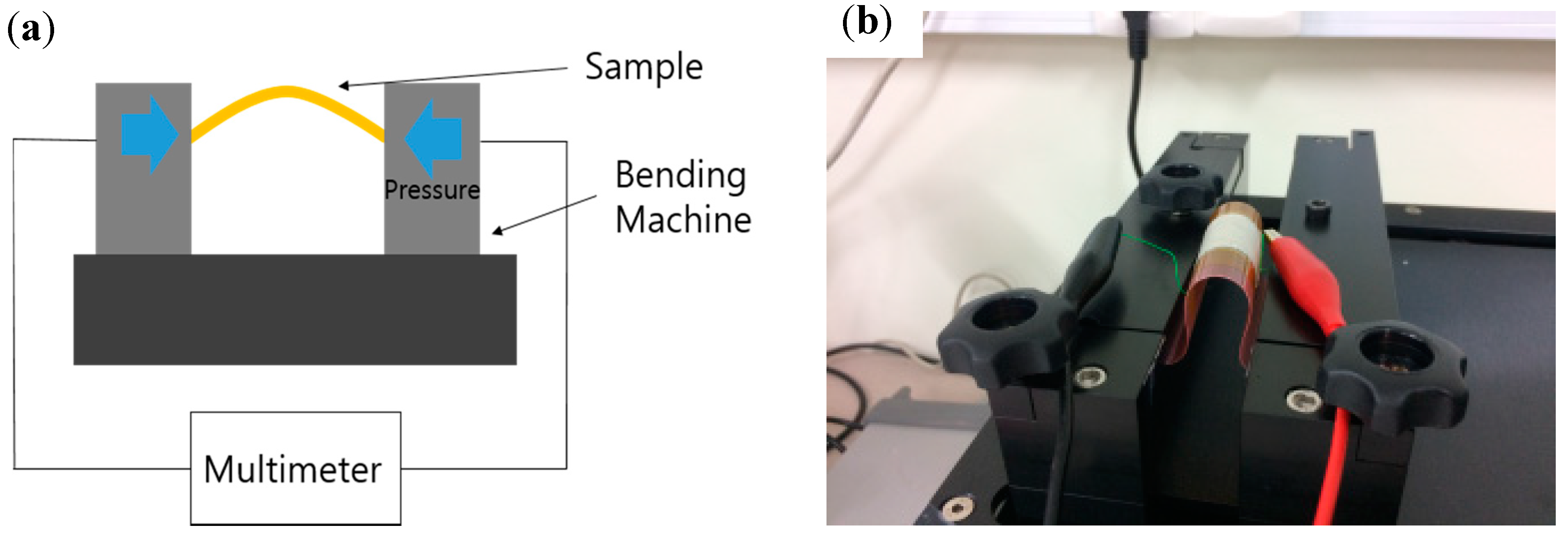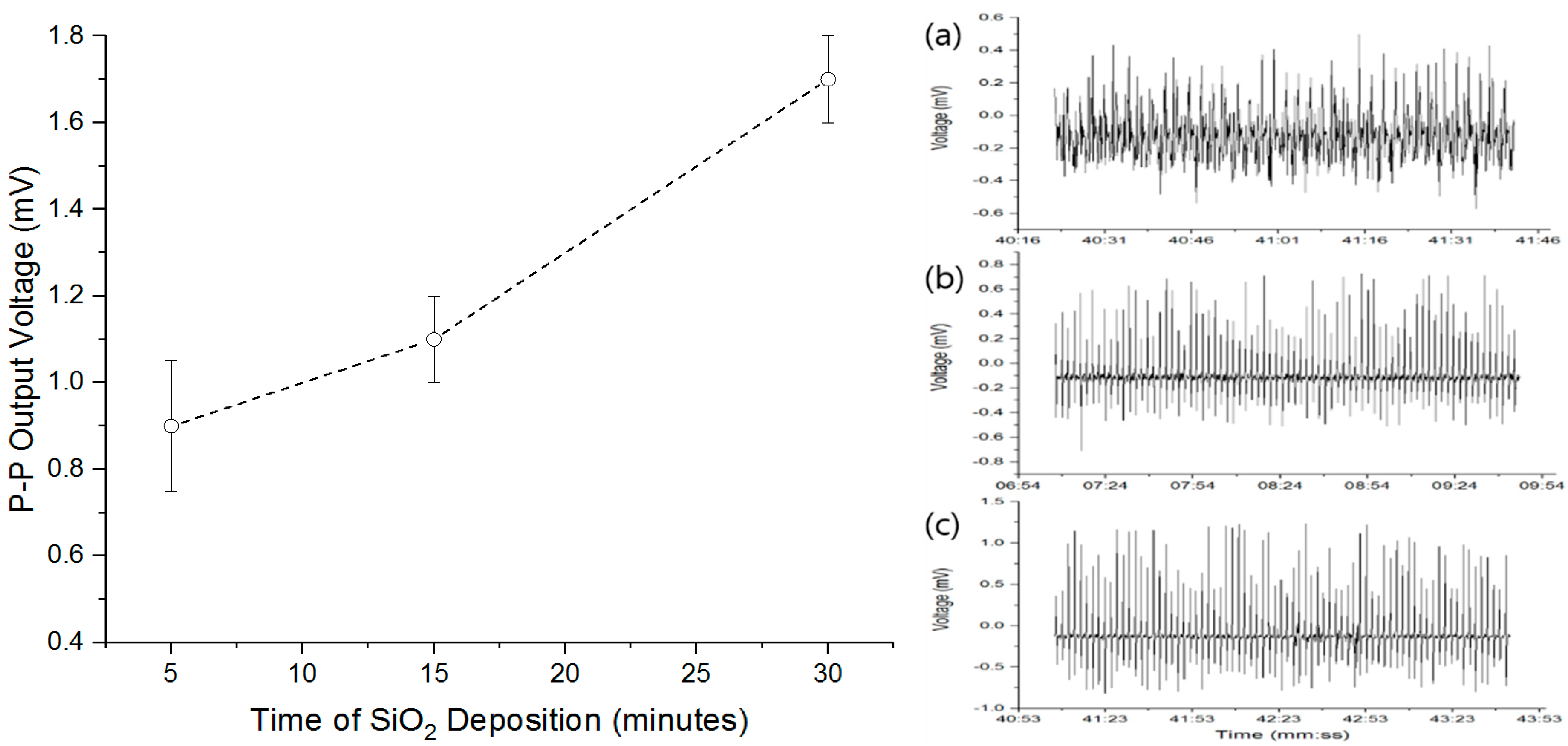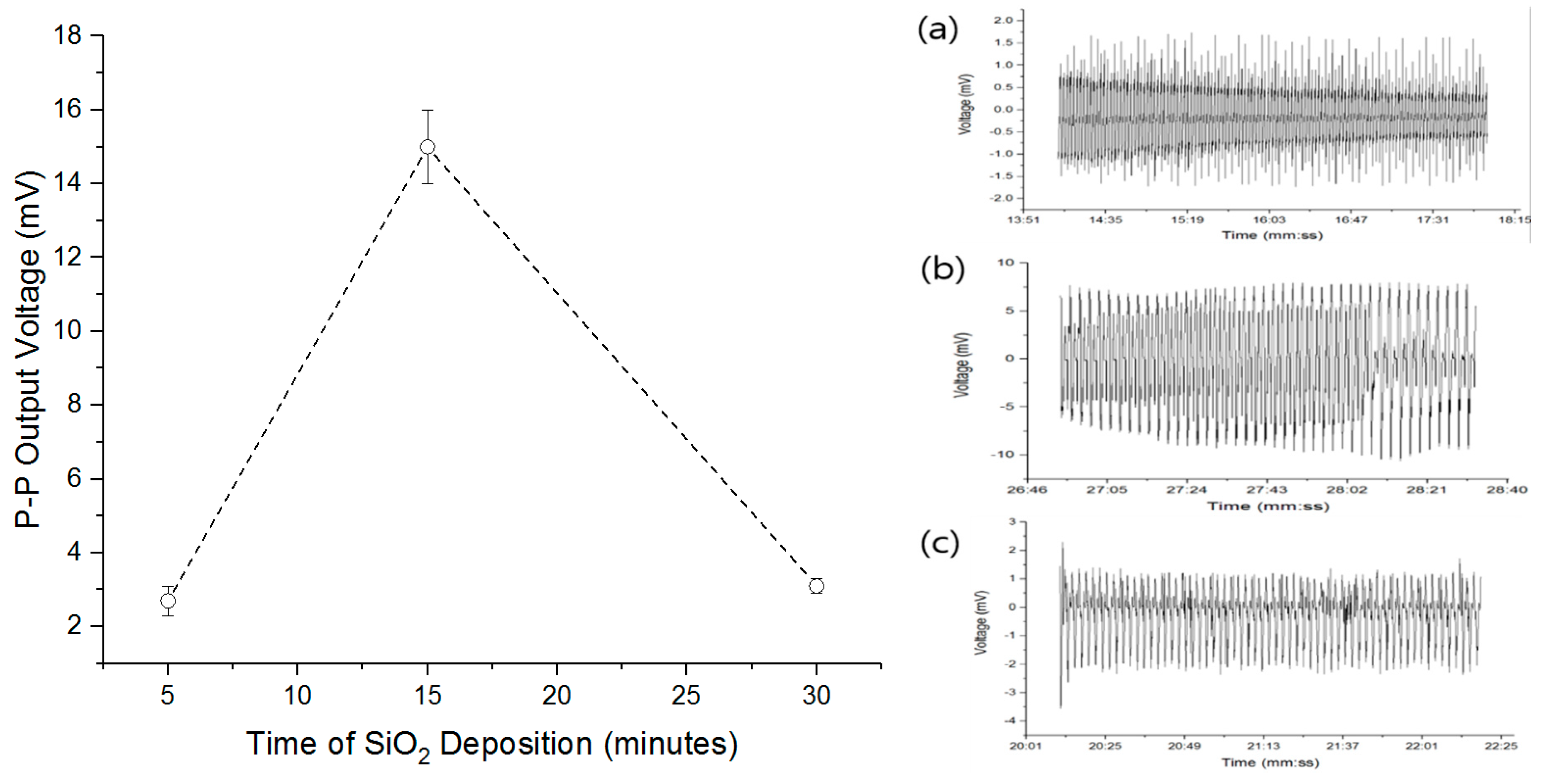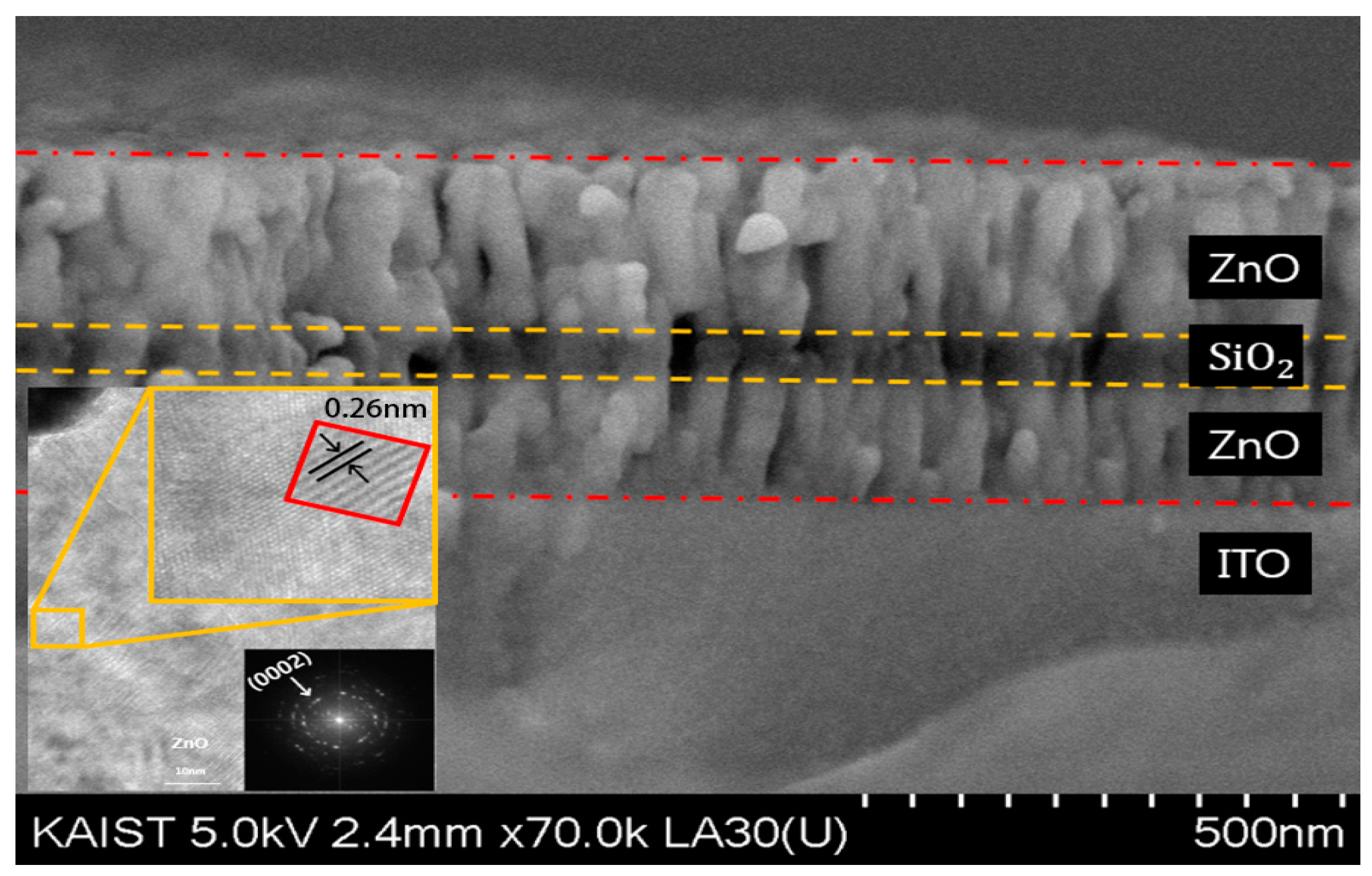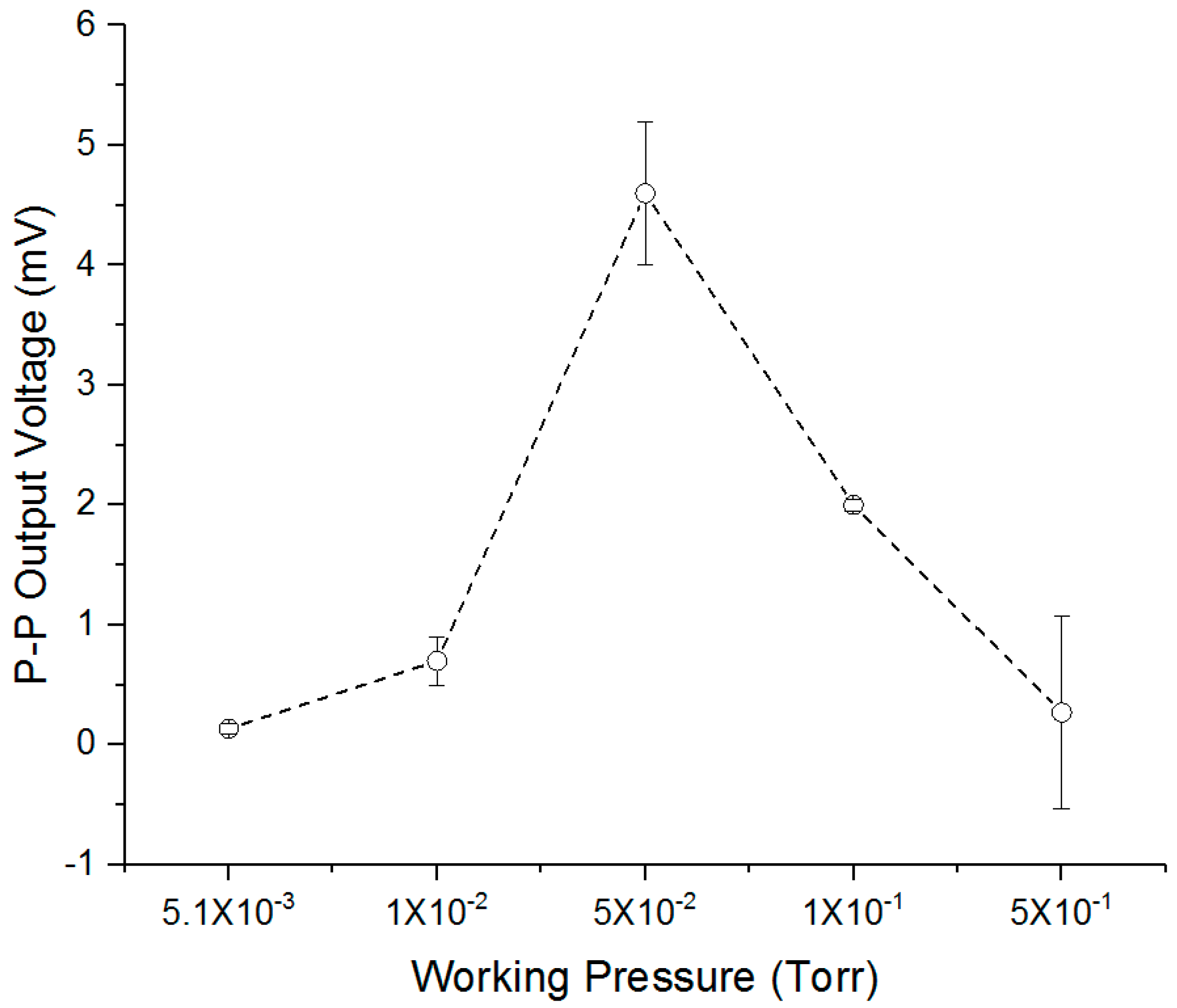1. Introduction
With the recent rapid development of more advanced wireless sensors for the Internet of Things (IoT) and wearable electronic devices, the demand for devices that can harvest various forms of ambient energy, such as mechanical vibration [
1], acoustic waves [
2], human biomechanical movement [
3], water waves [
4], environmental wind [
5], solar radiance [
6], and even waste heat [
7] has become increasingly urgent. Among the various energy harvesting technologies recently developed, piezoelectric energy harvesting technology is expected to play an important role as a potential energy source to power numerous sensors and devices in the near future. Piezoelectric technology converts mechanical energy into electrical energy by exploiting the piezoelectric effect in certain materials. Zinc oxide (ZnO) is a piezoelectric material frequently used for the fabrication of energy harvesting devices due to its large piezoelectric constant and superior film quality [
8]. It is also environmentally friendly and biocompatible because it contains no toxic elements such as lead. In general, lead-free ZnO-based piezoelectric materials are available for wearable piezoelectric devices. Moreover, the lead-free materials are particularly advantageous in transducers for the underwater and medical imaging applications mainly due to their relatively low density as well as lower acoustical impedance [
9,
10].
Many research teams worldwide have tried to develop ZnO-based energy harvesting devices while making an effort to maximize their piezoelectric performance. Prof. Z. L. Wang and his team from Georgia Institute of Technology proposed a method of fabricating vertically integrated structures to serve as nanogenerators using piezoelectric ZnO nanowires, polymethyl methacrylate (PMMA), and Au electrodes [
11]. The vertically integrated structures can be fabricated using conventional complementary metal-oxide-semiconductor (CMOS) process technology. They are also more durable than other device structures such as laterally integrated or radially integrated nanogenerators [
12,
13]. Their fabrication seems to be cost-effective because all that is required to fabricate these micro-energy generators is simply the stacking of thin film layers. Similarly, high-efficiency piezoelectric ZnO-based nanogenerators have also been developed for energy harvesting applications by forming ZnO/AlN-stacked layers [
14] and adopting free-carrier-modulated ZnO:N piezoelectric thin films [
15]. Moreover, there have been attempts to improve the piezoelectric materials or the device performance by adopting new electrodes or forming a p-n junction to block the screening effect based on energy band considerations [
15,
16,
17,
18]. The screening effect means that the piezoelectric potential (piezopotential) induced through the piezoelectric ZnO film is canceled by free electrons that exist inherently in a semiconductive ZnO material or electrode. This reduces the net potential across the ZnO film, thus degrading device performance. Therefore, to maximize the device output performance, it is essential to suppress the screening effect more effectively by controlling the ZnO free carrier density [
15]. Some research teams have used insulators or other semiconductor materials to form a good potential barrier to increase output voltages [
19]. Other research using AlN or various oxides (MoO
x, Cu
2O, and NiO) has been reported [
14,
16,
18,
20]. Despite such intensive research, only few studies were published using SiO
2 as an insulator [
21]. SiO
2, an excellent insulating material, is electrically reliable, biocompatible, non-toxic, cheap, and easy to fabricate. Therefore, it seems highly desirable to adopt SiO
2 as an insulating interlayer in ZnO-based piezoelectric devices.
In this paper, we present a study of various ZnO/SiO2-stacked thin film structures for flexible micro-energy harvesting devices. Two different groups of micro-energy harvesting devices, i.e., SiO2/ZnO/SiO2 micro-energy generators (SZS-MGs) and ZnO/SiO2/ZnO micro-energy generators (ZSZ-MGs), were fabricated by stacking both SiO2 and ZnO thin films on top of each other, and subsequently characterized. With a particular interest in the fabrication of flexible devices, all the ZnO and SiO2 thin films were deposited on flexible indium tin oxide (ITO)-coated polyethylene naphthalate (PEN) substrates using a radio frequency (RF) magnetron sputtering technique. The effects of the thickness and position of the deposited SiO2 films on the device performance were investigated by observing the variations in the output voltages in comparison with the ZnO single-layer device used as a control sample. As a result, compared to the ZnO single-layer device, all the ZSZ-MGs showed much better output voltages, while all the SZS-MGs showed slightly better output voltages. Among the ZSZ-MGs, the highest output voltages were obtained from the ZSZ-MG with the SiO2 thin films deposited at a deposition power of 150 W. It was also found that the output voltages were strongly dependent on the position and thickness of the SiO2 thin films in the ZnO/SiO2-stacked multilayer devices, in addition to the processing conditions.
2. Materials and Methods
All the ZnO and SiO2 thin films were deposited using an RF magnetron sputtering technique (Hanback Electronics, Korea). The standard deposition conditions included a base pressure of 2.7 × 10−6 Torr, working pressure of 1.0 × 10−2 Torr, and RF sputtering power of 200 W. Flexible ITO-coated polyethylene naphthalate (PEN) (Hanalin Tech, Gumi-shi, Gyeongsangbuk-Do, Korea) was used as a substrate for the purpose of making wearable devices. All samples were prepared to have the same size of 3 cm × 6 cm.
Various interlayer SiO
2 and ZnO thin films with different thicknesses were deposited at different positions in order to determine which ZnO/SiO
2-stacked multilayer configurations would generate better output voltages. At all stages of the experiments, the ZnO layer for SZS-MGs was deposited for one hour while for ZSZ-MGs, both the upper and lower ZnO layers were deposited respectively for 30 min. Immediately after depositing all the ZnO and SiO
2 film layers, the as-deposited device samples were annealed in an electric dehydration vacuum furnace (Daesung Electric Furnace, Ansan-City, Gyunggi-Do, Korea) at 150 °C for one hour. Then, the top Ag electrodes were made by coating Ag paste (CANS, ELCOAT P-100, Jinchemical, Korea) onto the annealed devices using the doctor blading technique [
18]. Next, aluminum wires were connected to the ITO bottom electrode and to the Ag paste top electrode of each device. Each sample device was evaluated under a mechanical bending/unbending test with a fixed moving speed and interval in a linear motion bending/unbending stage (Labtech Science, Korea), as shown in
Figure 1.
First of all, to identify which SiO
2 layer positions would generate better output voltages, we investigated two large device groups, i.e., SZS-MGs and ZSZ-MGs, illustrated in
Figure 2 and
Figure 3, respectively. Moreover, the effects of the working pressure and deposition power on the SiO
2 films were investigated in more detail to understand their influence on the output voltage. Both sputtering targets (ZnO: 4” diameter × 0.25” thick and SiO
2: 4” diameter × 0.125” thick) used for film deposition were manufactured by iTASCO, Korea. The output voltages were measured using a Keysight 34401A (CA, USA) digital multimeter. The piezoelectric micro-energy generators were bent with the middle part raised, also known as forward bending. The output voltages were measured while bending/unbending each device for 300 cycles.
3. Results and Discussion
A basic piezoelectric device consisting solely of a single layer of ZnO was fabricated for use as a control (reference) sample, as shown in
Figure 4. For comparison, we designed and fabricated various kinds of new piezoelectric micro-energy generator devices by stacking both ZnO and SiO
2 films in an effort to further enhance the output voltage. As shown in
Figure 2, the SZS-MGs are composed of a ZnO layer sandwiched between two SiO
2 layers. In contrast, the ZSZ-MGs are composed of a silicon dioxide (SiO
2) layer sandwiched between two ZnO layers, as shown in
Figure 3. The ZnO layer for SZS-MGs was deposited for one hour while for ZSZ-MGs, both the upper and lower ZnO layers were deposited respectively for 30 minutes with an RF power of 200 W, resulting in a total thickness of about 270 nm. The SiO
2 layers were deposited by sputtering with an RF power of 200 W for 5, 15, and 30 min, respectively. The output voltages were measured and compared to find out which device configurations could generate higher output voltages.
While the control MG device made up of a single layer of ZnO alone showed a relatively low output voltage of 0.7 mV, as shown in
Figure 4, better output voltages were obtained from the ZnO/SiO
2-stacked film devices, i.e., the SZS-MGs and ZSZ-MGs illustrated in
Figure 2 and
Figure 3. This is considered to be mainly due to the inserted SiO
2 insulating layers. The measured output voltages of the three SZS-MGs illustrated in
Figure 2 are plotted in
Figure 5. In the case of the devices with SiO
2 films deposited for times in the range from 5 min to 30 min, they produced slightly better output voltages ranging from about 0.9 to 1.7 mV. This seems to suggest that the thicker SiO
2 layers lead to better output voltages, but the magnitude of the output voltage is still small. The measured output voltages of the three ZSZ-MGs shown in
Figure 3 are plotted in
Figure 6. The ZSZ-MGs showed output voltages about 9 times larger than those of the SZS-MGs. The ZSZ-MG device with a SiO
2 film interlayered between both the top and bottom ZnO layers was observed to generate about 15 mV of peak to peak (P–P) output voltage where the SiO
2 film was deposited for 15 min. The deposition conditions of ZnO and SiO
2 thin films used for the SZS-MGs and ZSZ-MGs, mentioned respectively in
Figure 5 and
Figure 6, are summarized in more detail in
Table 1.
Therefore, the ZSZ-MGs showed better output voltages than the SZS-MGs after 300 bending/unbending cycles. Additionally, among the ZSZ-MGs, the SiO
2 films deposited at 200 W for 15 min were of a desirable thickness, leading to the generation of the highest output voltages. This is believed to be due to the blockage of electrons. The two thicker SiO
2 layers surrounding the ZnO layer, as shown in
Figure 2, can make it harder for electrons to flow into and out of the ZnO layer. This would suppress the screening effect while forming potential barriers, leading eventually to the elevation of the output voltage. On the other hand, when the SiO
2 film is placed as an interlayer between the top and bottom ZnO layers, as shown in
Figure 3, there will be a critical or optimum thickness of the SiO
2 film layer which acts as a barrier that helps to elevate the output voltage while suppressing the screening effect. Moreover, a thinner SiO
2 layer may allow relatively more electrons to flow through the oxide film. If the SiO
2 layer is thicker than the critical or optimum thickness, it may more effectively block the flowing of the electrons generated by the piezoelectric effect, thus reducing the net output voltage. The more detailed descriptions on the precise physical/electrical mechanism of our multilayered thin film devices remain our future work.
Table 2 shows the thicknesses of individual film layers. The SiO
2 film thickness was about 52 nm when the top ZnO film was 153 nm thick and the bottom one was 116 nm thick.
Figure 7 shows a cross-sectional view of the SiO
2 layer sandwiched between the top and bottom ZnO layers. The inset in the figure shows a high-resolution transmission electron microscopy (HRTEM) image and selected area electron diffraction (SAED) pattern of the ZnO film, indicating that the ZnO film has a crystalline form [
15]. The distance between the (0002) planes was found to be 0.26 nm. This observation is meaningful because the crystallinity of the ZnO film can have an influence on its ionic polarization, eventually affecting its piezoelectricity.
Comparing the output voltages of the SZS and ZSZ devices shown in
Figure 5 and
Figure 6, the ZSZ devices were found to exhibit better performance than the SZS devices. From this observation, we were inspired to further investigate the ZSZ devices in the hope of enhancing the device performance even further. First, we investigated the effects of working pressure on the output voltages of the ZSZ devices. We fabricated five ZSZ-MG samples with SiO
2 films deposited under various working pressures of 5 × 10
−1, 1 × 10
−1, 5 × 10
−2, 1 × 10
−2, and 5.1 × 10
−3 Torr.
Figure 8 shows the variations in the peak to peak (P–P) output voltages of these ZSZ-MGs with SiO
2 thin films deposited under different working pressures, indicating that there is a strong dependence of the output voltage on the working pressure during SiO
2 film deposition.
Table 3 summarizes the deposition conditions of both the ZnO and SiO
2 thin films used to fabricate these ZSZ-MGs. As shown in
Figure 8, the ZSZ device with an SiO
2 film deposited for 15 min with an RF power of 200 W at working pressure of 5 × 10
−2 Torr produced the best output performance (V
P-P = 4.5 mV) among the five samples. As shown in
Figure 9, the surface and grain morphologies of the deposited SiO
2 films seem to be affected by the working pressure, which may eventually have an influence on the output voltage.
The SiO
2 surface morphology appears to vary considerably depending on the working pressure. The scanning electron microscope (SEM) images in
Figure 9 show that the SiO
2 grains became smaller and denser as the working pressure was decreased.
Second, we also investigated the effects of deposition power on the output voltage of the ZSZ-MG devices. We fabricated four different ZSZ-MG devices with SiO
2 films deposited using various deposition powers of 50, 100, 150, and 200 W. The output voltage variations of those ZSZ-MGs are plotted in
Figure 10. To maintain a similar thickness for each deposited oxide film, the deposition time alone was controlled to be inversely proportional to the applied RF power while keeping all other process conditions constant.
The device measurements showed that the largest output voltage (35 mV) was generated by the ZSZ-MG device with a silicon dioxide (SiO
2) thin film deposited using 150 W for 22.5 min, as shown in
Figure 10. This may be due to the formation at 150 W of the relatively fine-grained surface morphology shown in
Figure 11. The deposition conditions of both ZnO and SiO
2 thin films are summarized in
Table 4.
